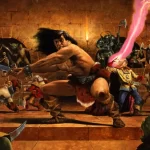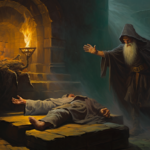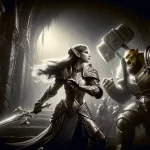One of the very coolest things you can do on Mastodon is follow hashtags. I’m always thinking of new hashtags I can follow; I was kind of surprised at myself that I hadn’t already followed the #HeroQuest hashtag, given how often I post about it and how much fun my family gaming group is having actually playing it.
That’s how I found out that you can just straight up buy a couple of new hero characters for HeroQuest. I kinda thought you have to buy a lot of new content to get a character (and you can, for many of them), but the monk and the rogue were just things you could pick up, paint and play.
I’ve done two of those things so far.
I’ve seen rankings of the HeroQuest characters, and some of the starting classes really don’t sit near the top of those rankings. The wizard, for instance. The wizard has a couple of spells that turn the tide, but most of the time, they are just there to buff everyone up and occasionally hit something with a stick. It’s pretty clear that the wizard isn’t going to be with us long. I’d say the same about the elf, but she gets her own expansion — the Mage in the Mirror — that gives her a lot of loot and new spells, and three solo missions before she calls in her friends. We’re getting into Gloomhaven territory here. So the elf is probably sticking around.
I’ve written how the Dwarf has had a recent glow-up, likely able to start being thought of as the tank of the group, and so the Barbarian joins the list of the eminently replaceable.
The monks can hit with two dice with no weapons at all, but they can wield a decent selection of the other weapons, though they cannot wear any armor at all.
The monks came in a little fighting arena and a little scroll that contained a map to a fighting tournament. The box contained both a male and a female monk; the base game has just one gender for all the starts (female for elf, male for the others). It’s nice to have a choice.
Monks come with elemental fighting styles, one each for water, air, earth and fire. The fire style is locked until all three of the other styles have been used. At the start of the monk’s move, if no enemy is in sight, the styles are reset, so the fire style will only ever be reached when in combat, when it will be the last style the monk can use unless they duck around a corner to get the monsters out of sight so that they can reset.
All the styles have two moves, though only one can be used.
- Water — Tidal Surge lets you split your movement and your action. Usually once you stop moving, you have to wait until your next turn to move again. This allows the monk to dash in, strike, and dash out of reach. Powerful stuff. The flip side has Twisting Torrent, which cancels a damage.
- Air — Eye of the Storm lets you make an unarmed attack (two dice) against every enemy adjacent to you, even diagonally. Soaring Dragon lets you jump a trap without rolling a die.
- Earth — Speak with Stone lets you search for traps and secret doors as one action. Strength of Mountain lets you use four attack dice for an unarmed attack, rather than two.
- Fire — Burning Spirit does a straight 2 body points of damage, ignoring defense, in a straight line until it hits a wall or a closed door. Touch of the Endless Inferno does a body point of damage to an adjacent enemy (not diagonally, I assume, since it doesn’t mention that specifically). At the end of the enemy’s next turn, it takes two more damage.
Monks have great utility in and out of battle. Unfortunately, the cards can’t be combined, so if you use Tidal Surge to get a free hit, you can’t use Strength of Mountain to double the attack dice in that turn. There’s the likelihood that the monk could get hit. (Is this true, though? Nothing in the card says you can only use one card per turn. Neither side of the Water card seems to require an action. All the other cards do, but it looks like Water can be combined with Air or Earth, or even Fire if set up carefully — Air and Earth already been used, use Water to get in position, do a Fire attack, and continue movement back out.)
The rogues came with both a male and a female elf, but they also came with two sets of the rogue cards, so potentially, two players could each play a rogue. How many rogues do we need?
Rogues start off with one attack die and a dagger, which is a one attack die weapon, so it’s not better than an unarmed attack, for a rogue. Daggers may be thrown, but that dagger will never be seen again, and new ones cost 25 gold. Better is to save up and buy the bandolier, which gives you infinite daggers and counts as a tool kit for disarming traps. At 300 gold, though, it will be a couple of adventures to get something I would count as mandatory for the rogue. If we bring the rogue to the table, I think we will have it come with a bandolier. It probably is meant to be that way, actually.
The rogue rules point out that for multiple attack moves, defense dice are rolled only for the first attack. Subsequent attacks have no defense. It’s this rule that the rogue relies upon to do damage.
The three rogue-specific abilities are always available.
- Ambidextrous — Once per turn, when you attack with a shortsword or dagger, you may make one additional attack with a dagger. That’s a 50% chance at an extra body point.
- Combat Mobility — You may move unseen through spaces occupied by monsters. They’re gonna know you’re there, though.
- Opportunistic Strikes — one extra combat die when attacking a monster next to another hero.
The rogue looks to be a more tactical hero than the monk. It has fewer base attack dice and fewer base defense dice, and combat mobility there to put the rogue in danger. Since daggers may be thrown, Ambidextrous means two ranged attacks per turn, but the damage is low unless the monster is next to another hero. A ranged attack at a monster next to another hero would be the best situation, with Combat Mobility, Ambidextrous and Opportunistic Strikes working together to throw a potential four attack dice, two of which would ignore defense. The rogue is a one trick pony, but it’s a good trick.
Which will we choose? We’ll find out. I’m excited to see how both these new classes handle on the table.






